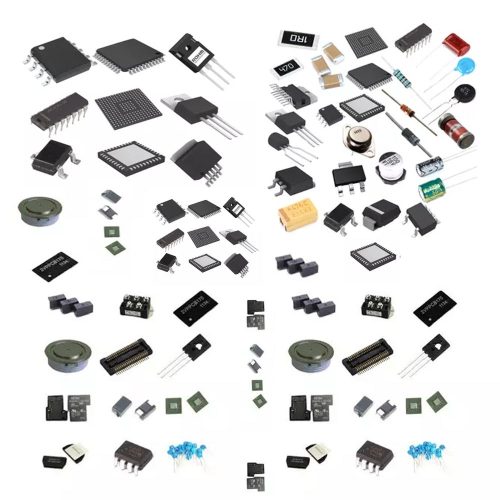MSP430FR6927IRGCT Overview
The MSP430FR6927IRGCT is a low-power, FRAM-based 16-bit microcontroller designed for energy-conscious industrial and battery-powered systems. It combines a 16-bit RISC CPU with non-volatile FRAM memory to deliver faster writes and higher write endurance than typical flash-based MCUs. The device targets designs that need more reliable data logging, quicker in-field updates, and lower active and standby power. It offers an integrated set of analog and digital peripherals for mixed-signal control, plus industry-standard serial interfaces for easy subsystem integration. Learn more from IC Manufacturer.
MSP430FR6927IRGCT Technical Specifications
| Parameter | Value |
|---|---|
| CPU | 16-bit RISC, single core |
| Maximum clock | 16 MHz |
| Non-volatile memory | FRAM, 64 KB |
| SRAM (data) | 2 KB |
| ADC | 12-bit SAR analog-to-digital converter |
| Operating voltage | 1.8 V to 3.6 V |
| Temperature range | -40 ??C to +85 ??C (industrial) |
| Package | 48-pin QFN (RGC suffix) |
| Serial interfaces | eUSCI modules for UART, SPI, and I2C |
| Timers | Multiple 16-bit timers with capture/compare |
| Peripherals | DMA, comparator, RTC-capable timers |
| Low-power modes | Multiple LPMs for ultra-low standby consumption |
MSP430FR6927IRGCT Key Features
- FRAM non-volatile memory delivering faster, higher-endurance writes than flash; it matters for frequent data logging and configuration storage.
- 16-bit RISC core with deterministic execution for efficient control code and lower cycle counts compared with many 8-bit options.
- Low-voltage operation from 1.8 V to 3.6 V, enabling compatibility with single-cell lithium and common industrial supplies for broader design flexibility.
- Integrated analog and serial peripherals (12-bit ADC, eUSCI for UART/SPI/I2C) that reduce external component count and speed integration.
- Multiple low-power modes to optimize active versus standby energy use, improving battery life in portable and energy-sensitive applications.
- Compact 48-pin QFN package for denser board layouts while keeping significant I/O and peripheral routing available.
Typical Applications
- Battery-powered sensors and data loggers that need frequent non-volatile writes and long-term data retention with lower energy per write than flash-based solutions.
- Industrial metering and control nodes that require deterministic 16-bit control, reliable non-volatile settings storage, and robust serial connectivity for field buses.
- Portable medical and handheld devices that benefit from low-voltage operation, compact packaging, and integrated ADCs for analog sensing and monitoring.
- Consumer or building automation endpoints that demand low standby current, rapid wake-up, and field-programmable memory for firmware updates and configuration changes.
MSP430FR6927IRGCT Advantages vs Typical Alternatives
The MSP430FR6927IRGCT pairs FRAM endurance and write speed with a proven 16-bit core to deliver lower system power and faster non-volatile updates versus flash-based microcontrollers. Designers get more reliable data logging and more write cycles without external EEPROM. The integrated 12-bit ADC, timers, DMA, and multi-protocol eUSCI modules reduce BOM count compared with MCU-plus-peripheral discrete solutions. The industrial voltage and temperature ranges make it a compact, lower-power alternative for embedded control and sensing applications.
🔥 Best-Selling Products
MSP430FR6927IRGCT Brand Info
The MSP430 family is produced by Texas Instruments, a long-standing semiconductor supplier to industrial and embedded markets. This device reflects TI??s emphasis on ultra-low-power MCUs with integrated mixed-signal peripherals, FRAM-based non-volatile memory, and broad design tools and ecosystem support for fast prototyping and production deployment.
FAQ
What memory type does it use?
The device uses FRAM non-volatile memory. FRAM provides faster write times and higher write endurance compared with traditional flash, which benefits frequent logging and runtime configuration changes.
🌟 Featured Products
-

“Buy MAX9312ECJ+ Precision Voltage Comparator in DIP Package for Reliable Performance”
-

QCC-711-1-MQFN48C-TR-03-1 Bluetooth Audio SoC with MQFN48C Package
-

0339-671-TLM-E Model – High-Performance TLM-E Package for Enhanced Functionality
-

1-1415898-4 Connector Housing, Electrical Wire-to-Board, Receptacle, Packaged
What supply voltages are supported?
Supply operation spans the low-voltage range commonly used in portable and industrial systems, enabling reliable operation from 1.8 volts up to 3.6 volts for single-cell battery and regulated bus compatibility.
Which serial interfaces are available?
Integrated eUSCI modules provide serial communication for UART, SPI, and I2C. These interfaces enable easy connection to sensors, radios, and other peripherals without extra bridge chips.
📩 Contact Us
How does it help reduce BOM cost?
On-chip ADC, timers, DMA, and multi-protocol serial interfaces reduce the need for discrete ADCs, UART/SPI bridges, and external memory, lowering board area and component count.
Is it suitable for battery-powered designs?
Yes. Multiple low-power modes, low-voltage operation, and FRAM??s low energy-per-write characteristics make it suitable for battery-powered sensing and logging applications that require long runtime.




